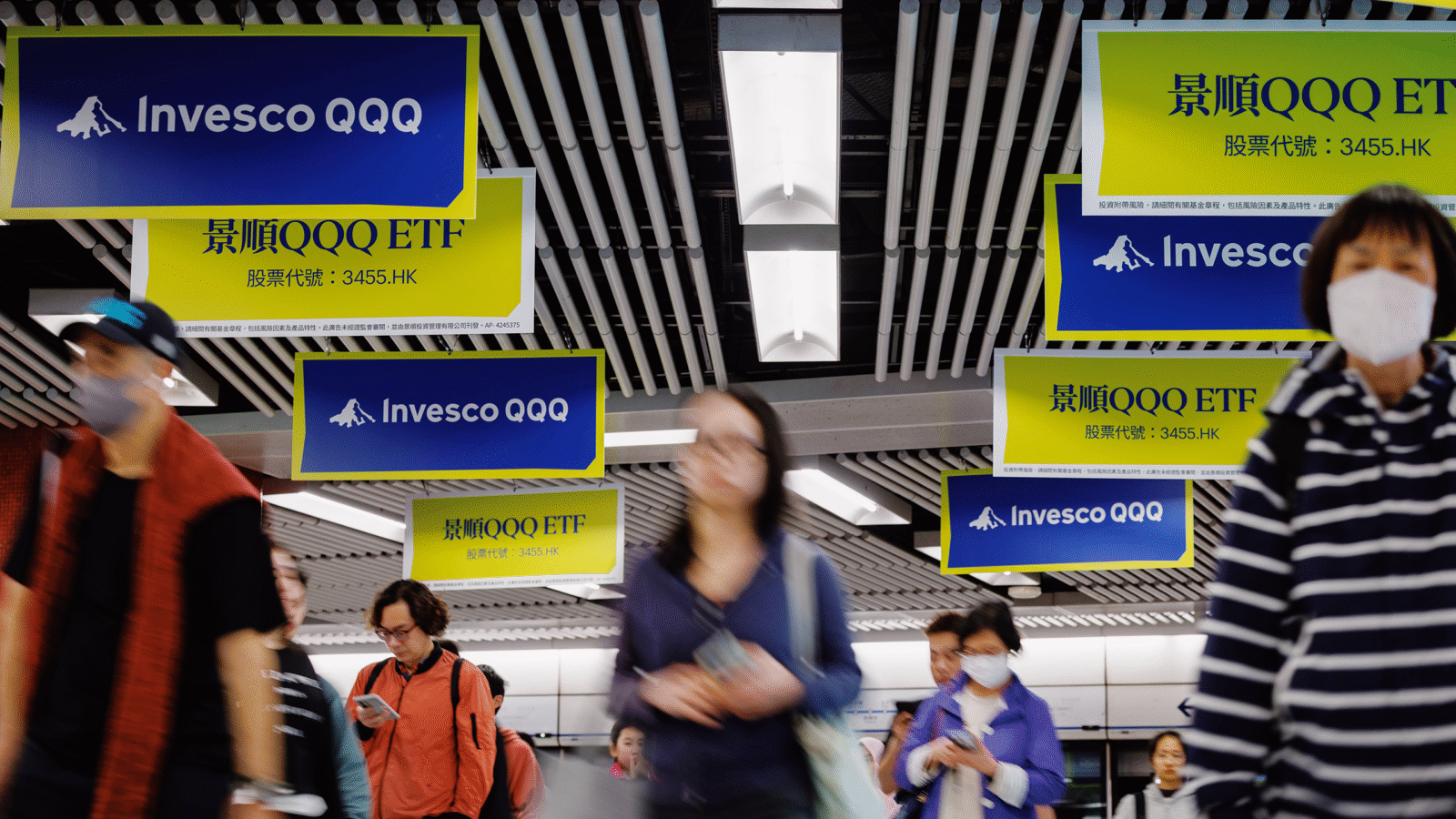Good morning, and happy Monday.
Too much is never enough.
Asset managers launched 1,308 new ETFs globally in the first six months of 2025, according to a report last week by ETFGI. During that time, 266 exchange-traded funds were shuttered, bringing the net increase worldwide to 1,042, up from 878 in the first half of 2024. In the US alone, there were 481 new ETFs in the first half of the year, ahead of the entire Asia Pacific region (excluding Japan), at 399, and Europe, at 198. While the US ranks low compared with other developed countries in areas like health care (10th), press freedom (57th) and happiness (24th), it sure has a lot of ETF launches.
Has anyone started a campaign to edit the US motto to “ETF Pluribus Unum?”
Why Invesco Wants QQQ to Become an Open-End Fund

Invesco QQQ Trust is one of the most profitable ETFs on the market today. Not so much for Invesco.
The firm filed Thursday with the Securities and Exchange Commission to change QQQ from a “unit investment trust” — a structure unique to it and a handful of other long-standing ETFs — to an open-end fund. The change would enable Invesco to earn more revenue from the $355 billion fund and give it authority over spending, roughly a quarter of which has gone toward marketing. If the request is approved, both Invesco and shareholders could see a long overdue windfall, increasing shareholders’ earnings by up to $70 million, according to Morningstar analyst Bryan Armour. The change is also expected to bring down the expense ratio for one of the most popular ETFs on the planet.
“Because QQQ has grown to be such a massive ETF… that has really increased that marketing budget, and that’s why we see QQQ sponsoring so many different events, and sports, and stadiums, and all sorts of things,” Armour said. “What this [filing] does is it gives them discretion over how to spend that fee revenue, with the expectation that they would probably keep more of that for themselves.”
Reve-Q
The QQQ saga began when the Nasdaq launched the fund in 1999 as a UIT, an “an obscure structure” dating to the early 90s, per Bloomberg. In the early 2000s, the index transferred ownership to Powershares, Invesco’s owner at the time. If approved, the move would make Invesco QQQ’s trustee, replacing its current trustee, BNY Mellon, and making the company the fund’s investment adviser. The move would also lower the fund’s expense ratio by 2 basis points to 0.18% — money that would go back to QQQ shareholders. The fund itself already earns $711 million in revenue each year, with about $180 million of that going toward marketing. The rest is split between BNY Mellon and the Nasdaq. “They would still, I’m sure, do marketing, but any cut to that marketing spend would basically be profit,” Armour said. “The stock price is up almost 15% [on Friday] for Invesco as a result, because that’s a considerable increase.”
- Invesco’s QQQ Trust Series 1 fund has $355 billion in assets under management, making it the fifth-highest ETF by assets under management. The current expense ratio is 0.2%.
- QQQ is currently up 10% year to date YTD as of Friday afternoon.
Finally. So, why is Invesco just now hopping on the open-end fund train, given that most of the other ETFs on the market are already classified that way? Armour said the reasons are twofold: to benefit Invesco and to enrich investors. “It’s an opportunity for investors to get a fee reduction, and then also QQQ can do securities lending and dividend reinvestments, which it couldn’t do previously in the UIT structure,” he said. “I think it’s a win for Invesco and investors.”
Bitcoin with Bubblewrap: Calamos Preps Laddered ETFs
Calamos is planning to take Bitcoin investing to a new level, and it wants to offer ETF customers a ladder to get there.
The company this week filed for approval from the Securities and Exchange Commission to offer three new exchange-traded funds: the Calamos Laddered Bitcoin Structured Alt Protection, Laddered Bitcoin 80 Series Structured Alt Protection; and Laddered Bitcoin 90 Series Structured Alt Protection ETFs. They would be the latest in the firm’s suite of Bitcoin ETFs that offer varying levels of downside protection, a product line Calamos launched earlier this year. Providing exposure to Bitcoin with limits on losses (and upside) can appeal to financial advisors and investors who have been interested in crypto, but leery of the volatility, said Matt Kaufman, head of ETFs at Calamos.
“The financial advisory community hasn’t adopted Bitcoin or crypto in a large way,” he said. “This creates a bridge into Bitcoin for people who otherwise wouldn’t approach it.”
Step by Step, Bitcoin by Bitcoin
The proposed ETFs would use options and have exposure to the prices of up to five ETFs: the iShares Bitcoin Trust ETF (IBIT), Grayscale Bitcoin Mini Trust (BTC), Bitwise Bitcoin ETF (BITB), Fidelity Wise Origin Bitcoin Fund (FBTC) and Ark 21 Shares Bitcoin ETF (ARKB). The funds are “laddered” in the sense that they would invest in underlying Bitcoin ETFs with different target outcome periods, meaning diversification in the timeframes in which they are exposed to different Bitcoin ETFs, according to the prospectuses. What makes the downside protection compelling is that investors may feel comfortable allocating more than the 1% to 2% to Bitcoin that asset managers have recommended, Kaufman said. That may also be the case for early-stage crypto investors, whose wealth has grown exponentially, and who now want to pull back on risk and trade pure Bitcoin holdings for the ETFs, he said.
“You can actually increase risk-adjusted returns in the portfolio,” he said.
The firm’s protected Bitcoin suite has grown in number of products and total assets since January:
- Calamos has nine such ETFs, providing downside protection at levels of 80% (40% upside limit), 90% (24.7% limit) and 100% (10% limit), with issuance dates starting in January, April and July.
- Assets in those funds represent about $130 million, according to the company.
Paying for Protection: Bitcoin ETFs, particularly those that provide novel investment strategies, might be the best fit for nonbelievers. “Although volatile, if you are investing in Bitcoin and are a believer in the asset, I’m not sure why you would want to cap your upside,” said Kevin Feig, a former head of risk at crypto exchanges Coinbase and Kraken, who founded advisory firm Walk You To Wealth. “Additionally, investors need to be aware of the expense ratio associated with these types of funds, especially considering that fees associated with existing Bitcoin ETFs are likely to reduce as the ability to hold Bitcoin, without the need for an ETF, becomes more widely available in retirement accounts.”
Best International Equity ETFs of 2025

ETFs are booming in the US, but that doesn’t mean investors are keeping their investments stateside.
International equity ETFs that invest in publicly traded companies have surged this year, posting returns of 20% or more and cementing international funds at the top of the heap of the best performing funds of 2025’s first half. The massive gains were due to overperforming European markets and strong performing sectors in other countries.
The outperformance in Europe, relative to both the US and international stocks more broadly, can be attributed to an “increased willingness” for those countries to invest in companies that help drive economic growth, said Zachary Evens, a Morningstar research analyst. “Banks and utilities and industrials and communication service companies, like telecoms, these companies are more boring,” he said. “They don’t typically grow very fast, but they benefit from broad economic growth, so a lot of the outperformance has been concentrated in some of those stocks.”
Across The Pond
European stocks have outperformed their US counterparts for the past three years, reversing a trend of US dominance that began following the Great Recession, with the MSCI EMU Index outpacing the S&P 500 by more than 35 percentage points since 2022, according to Schwab. International stocks in general have also beaten American stocks, as measured by the MSCI EAFE Index. Some of the top-performing international markets ETFs so far this year are:
- The Schwab International Dividend Equity ETF (SCHY), which tracks a market-cap-weighted index of foreign stocks and had YTD returns of 20.7%.
- The Vanguard Total International Stock ETF (VXUS), which has an expense ratio of .05% and holds more than 8,600 stocks in companies from both developed and emerging markets. It posted YTD returns of 18.3%.
- The SPDR Portfolio Emerging Markets ETF (SPEM), which tracks emerging markets in countries like China, India, Brazil, South Africa, and Mexico and had YTD returns of 14.3%.
Still, diversification is key to avoiding region-specific downturns. “If Spain grows by a lot, but France falters, then diversification will even that out… That also goes for the sector side,” said Evens. “You would be better suited to be more diversified across sectors and countries to minimize those negative impacts.”
All Hail the Sector. Sector performance tends to be the main driver of stock performance, with US markets leaning heavily on tech companies in recent years. Still, outside factors — inflation, political deals, tariffs — have an impact on sectors, which in turn affects markets, according to Evens. “What impacts the performance of those sectors would be more idiosyncratic risks or geopolitical factors, or economic factors,” he said. “Weighing those is how investors can think about potential outperformance or underperformance of the respective markets.”
Extra Upside
- Three’s Company. This trio of ETFs can help rebalance a portfolio.
- Interest Piqued. Ripple’s cofounder moved some XRP ahead of an ETF launch, raising some eyebrows.
- Extraterrestrial. Space ETFs are blasting off.
ETF Upside is written by Emile Hallez. You can find him on LinkedIn.
ETF Upside is a publication of The Daily Upside. For any questions or comments, feel free to contact us at etf@thedailyupside.com.
